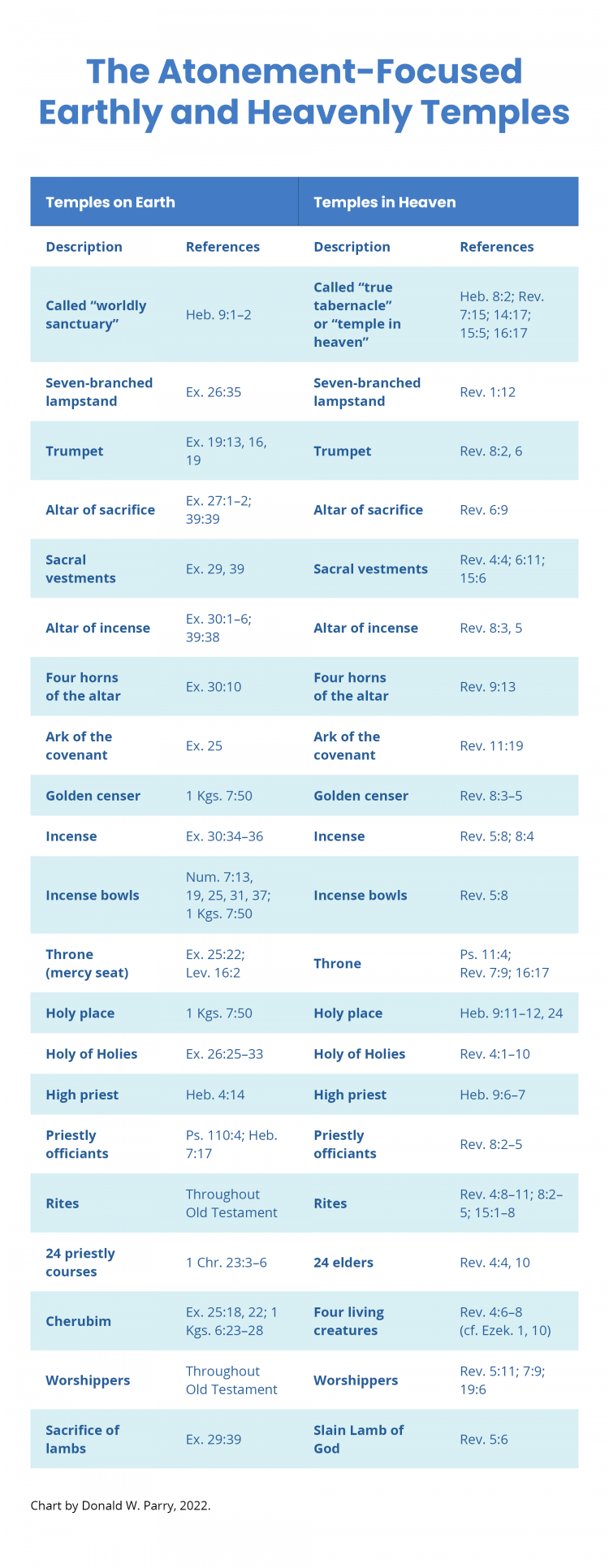You are here
The Atonement-Focused Earthly and Heavenly Temples
| Title | The Atonement-Focused Earthly and Heavenly Temples |
| Publication Type | Book Chapter |
| Year of Publication | 2022 |
| Authors | Parry, Donald W. |
| Book Title | The Jesus Christ Focused Old Testament: Making Sense of a Monumental Book |
| Chapter | 52 |
| Pagination | 138-140 |
| Publisher | Book of Mormon Central |
| City | Springville, UT |
Show Full Text
Explicit references and intimations of a heavenly temple are scattered throughout the Bible. The book of Psalms hints at the idea of a heavenly temple (Ps. 11:4; 102:19; cf. 150:1), and Isaiah’s vision of the lord “sitting upon a throne, high and lifted up” (Isa. 6:1) with the presence of seraphim likely pertains to the heavenly temple (see also 1 Kgs. 22:19; Ezek. 1, 10; and others). John explicitly referred to the heavenly temple with such expressions as “another angel came out of the temple which is in heaven” (Rev. 14:17; emphasis added) and “there came a great voice out of the temple of heaven” (Rev. 16:17; italics added; cf. 7:15; 14:15; 15:5–8).
Writing to the Hebrews, Paul compared and contrasted the earthly temple to the heavenly temple. He called the earthly temple “a worldly sanctuary” (Heb. 9:1) and the heavenly temple the “true tabernacle, which the lord pitched and not man” (Heb. 8:2). The earthly priests, wrote Paul, “serve unto the example and shadow of heavenly things” (Heb. 8:5), but Jesus Christ is the “minister” of the heavenly temple (Heb. 8:2). Under the Mosaic law, the priests went into the “first tabernacle” to accomplish “the service of God. But into the second [tabernacle (i.e., the heavenly temple)] went the high priest [Jesus] alone once every year, not without blood, which he offered for himself, and for the errors of the people” (Heb. 9:6–7).
The accompanying chart sets forth a number of similarities between the earthly and heavenly temples. Both temples had seven-branched lampstands, officiants with sacred vestments, altars of sacrifice, and altars of incense; both had the equivalent of a holy place and a Holy of Holies, where God’s throne (i.e., the mercy seat) was located. Many differences also exist between the two temples. For instance, the earthly temple possessed manmade, lifeless cherubim, replicas of the real living creatures that exist in the temple of heaven (Rev. 4:6–8; cf. Ezek. 1, 10). The earthly temple was built by the hands of man, but the heavenly temple was erected through the workmanship of God Himself (Heb. 8:2).
In sum, the earthly temple is an image of the heavenly temple where God dwells. This is significant, as it (1) allows us to recognize that the earthly temple’s rituals help us to gain access to the heavenly temple, (2) helps us to recognize that Jesus Christ and His Atonement is the central focus of both temples, and (3) assists us in learning that various aspects of the earthly temple are symbolic representations of things in the heavenly temple.
|
Temple on Earth |
Temple in Heaven |
||
|---|---|---|---|
|
Description |
References |
Description |
References |
|
Called “worldly sanctuary” |
Heb. 9:1–2 |
Called “true tabernacle” or “temple in heaven” |
Heb. 8:2; Rev. 7:15; 14:17; 15:5; 16:17 |
|
Seven-branched lampstand |
Ex. 26:35 |
Seven-branched lampstand |
Rev. 1:12 |
|
Trumpet |
Ex. 19:13, 16, 19 |
Trumpet |
Rev. 8:2, 6 |
|
Altar of sacrifice |
Ex. 27:1–2; 39:39 |
Altar of sacrifice |
Rev. 6:9 |
|
Sacral vestments |
Ex. 29, 39 |
Sacral vestments |
Rev. 4:4; 6:11; 15:6 |
|
Altar of incense |
Ex. 30:1–6; 39:38 |
Altar of incense |
Rev. 8:3, 5 |
|
Four horns of the altar |
Ex. 30:10 |
Four horns of the altar |
Rev. 9:13 |
|
Ark of the covenant |
Ex. 25 |
Ark of the covenant |
Rev. 11:19 |
|
Golden censer |
1 Kgs. 7:50 |
Golden censer |
Rev. 8:3–5 |
|
Incense |
Ex. 30:34–36 |
Incense |
Rev. 5:8; 8:4 |
|
Incense bowls |
Num. 7:13, 19, 25, 31, 37; 1 Kgs. 7:50 |
Incense bowls |
Rev. 5:8 |
|
Throne (mercy seat) |
Ex. 25:22; Lev. 16:2 |
Throne |
Ps. 11:4; Rev. 7:9; 16:17 |
|
Holy place |
1 Kgs. 7:50 |
Holy place |
Heb. 9:11–12, 24 |
|
Holy of Holies |
Ex. 26:25–33 |
Holy of Holies |
Rev. 4:1–10 |
|
High priest |
Heb. 4:14 |
High priest |
Heb. 9:6–7 |
|
Priestly officiants |
Ps. 110:4; Heb. 7:17 |
Priestly officiants |
Rev. 8:2–5 |
|
Rites |
Throughout Old Testament |
Rites |
Rev. 4:8–11; 8:2–5; 15:1–8 |
|
24 priestly courses |
1 Chr. 23:3–6 |
24 elders |
Rev. 4:4, 10 |
|
Cherubim |
Ex. 25:18, 22; 1 Kgs. 6:23–28 |
Four living creatures |
Rev. 4:6–8 (cf. Ezek. 1, 10) |
|
Worshippers |
Throughout Old Testament |
Worshippers |
Rev. 5:11; 7:9; 19:6 |
|
Sacrifice of lambs |
Ex. 29:39 |
Slain Lamb of God |
Rev. 5:6 |
Terms of Use
Items in the BMC Archive are made publicly available for non-commercial, private use. Inclusion within the BMC Archive does not imply endorsement. Items do not represent the official views of The Church of Jesus Christ of Latter-day Saints or of Book of Mormon Central.
Bibliographic Citation
Subscribe
Get the latest updates on Book of Mormon topics and research for free

